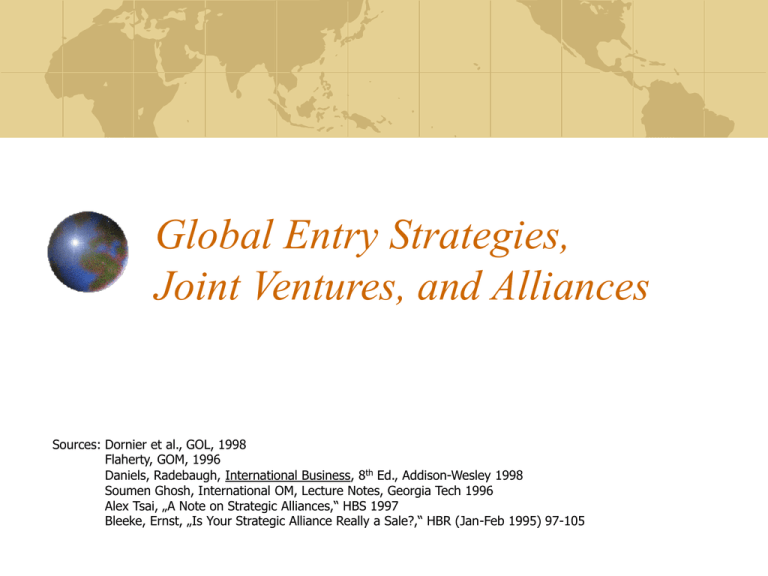Global Entry Strategies
advertisement

Global Entry Strategies, Joint Ventures, and Alliances Sources: Dornier et al., GOL, 1998 Flaherty, GOM, 1996 Daniels, Radebaugh, International Business, 8th Ed., Addison-Wesley 1998 Soumen Ghosh, International OM, Lecture Notes, Georgia Tech 1996 Alex Tsai, „A Note on Strategic Alliances,“ HBS 1997 Bleeke, Ernst, „Is Your Strategic Alliance Really a Sale?,“ HBR (Jan-Feb 1995) 97-105 Overview Entry Strategies Strategic Alliances Entry Strategies Information Sources about Overseas Suppliers Source Professional contacts Trade Journals Directories Trading companies Import brokers Foreign subsidiary Trade fairs Foreign trade offices Usage 48% 44% 31% 30% 24% 22% 16% 13% Entry Strategies Supplier Ratings on a National Basis Country Avg. QualAvg. Serv.Avg. Price Canada 5 4 5 Japan 2 5 12 Mexico 12 15 6 Germany 1 1 9 UK 4 3 7 France 6 11 11 India 16 16 14 Sth Korea 9 6 1 Taiwan 10 8 2 South America 13 14 16 Entry Strategies Trade and Communication Channels / Buying Channel Assigned buyer in purchasing unit Manufacturer‘s representative Foreign buying office Import broker Trading company Foreign subsidiary Import merchant State trading agency Use [%] 38% 34% 10% 10% 8% 7% 5% 1% Entry Strategies Choice of International Entry Mode Exporting Tapping foreign markets through marketing channels Licensing (also Franchising) Operations granted to the licensee in exchange for lump sum payment, per unit royalty fee, or proportion of profits Joint Venture (also Management Contract) Ownership split agreement Wholly Owned Subsidiary Locating own operations in a foreign site Entry Strategies Advantages/Disadvantages of Entry Modes Entry ModeControlResource Dissemination Commitment Exporting high medium Licensing low low Joint Venture medium medium Subsidiary high high Risk low high medium low Entry Strategies Entry Mode Variables Environmental variables resource commitment Transaction Variables risk Country risk Location familiarity Demand conditions Volatility of competition Value of firm specific know-how Tacit nature of knowhow Strategic variables - control Extent of national differences Extent of scale economies Global concentration Entry Strategies Classification of Entry Strategies Production Ownership Equity arrangements Non-equity arrangements Production Location Home Country Foreign country Exporting Wholly owned opns Partially owned opns Joint ventures Equity alliances Licensing Franchising Management contracts Turnkey operations Overview Entry Strategies Strategic Alliances Types of Alliances Contractual Agreements Equity Arrangements Traditional Contracts Non-Traditional Contracts No New Entity Creation of New Entity Dissolution of Entity Arms-length Joint R&D Minority Equity Investments Joint Venture Mergers Buy/Sell Contracts Franchising Joint Product Development Long Term Sourcing Licensing Cross-Licensing Acquisitions Equity Swaps Joint Manufacturing Joint Marketing Shared Distribution Shared Service Standard Setting Research Consortia Types of Alliances STRATEGIC IMPORTANCE Acquisition Minority Interest High Joint Venture Joint Marketing Joint Development Projects Medium Licensing Agreements Alliance/Consortia Commercial Contracts Low Technology Trials Low High LEVEL OF COMMITMENT Strategic Alliances Definition Strategic Alliance = Cooperative Agreement Long-term, explicit agreement between at least two firms Exchange can involve financial renumeration, goods/services, information, or a combination of the three Strategic Alliances Why do Firms Enter into Strategic Alliances? Transaction Cost Theory: Transactions either through hierarchies (i.e., within the firm) or through markets (i.e., externally) If transactions occur more often, parties may be better off negotiating a long-term contract Uncertainties when contract complex => contract incomplete/ re-negotiation; also holds if investment in assets are made for only one (potential customer) As external market transactions become more costly, a firm is more apt to internalize its activities to economize on transaction costs (excludes the possibility of opportunistic behavior by partner) Strategic Alliances Incentives to Enter Strategic Alliances Information exchange Reduce risk and search costs E.g., Technology transfer or technological complementarity • SMEs: cut risk through research sponsored by multiple big firms • Big firms: mitigate risk by supporting multiple innovative SMEs Complementary resources New entrant gains access to efficient production facilities, established channels of marketing and distribution, custr loyalty Existing competitor may share new technology for rapid expansion of market share in response to revolutionary innovations Strategic Alliances Incentives to Enter Strategic Alliances (cont’d) Economies of scale Until a new entrant has reached it own econs of scale in prodn, it is at a significant cost disadvantage => take part in competitor‘s econs of scale Competitor may reduce average unit cost and create add‘l entry barrier International expansion International expansion through a domestic partner at reduced risk (e.g., for commercialization) May be appropriate if speed of deployment important Often chosen by small firms (less capital intensive) or as a result of trade laws/restrictions Strategic Alliances Types of Strategic Agreements between Firms R&D Licensing Agreement Joint Venture Effect on cooperating firms • • • • New legal entity Operating (own facilities) vs. non-operating (admin) joint venture Mutual hostage position by combining real & financial assets => Incentives to share technology and info, invest in relationshipspecific assets, monitor each other Effect on market • Increase in market power by binding upstream suppliers or downstream distributors => higher entry barrier Strategic Alliances Myths „We‘re better off partnering with X than competing against it in our core business” „By joining forces with another second-tier company, we can create a strong company while fixing our problems together” „We need a strong partner to improve our skills” „By partnering with another company in our industry, we can access its new products and technologies while minimizing our investments in core products and technologies” “We can use an alliance to raise capital without giving up management control” Strategic Alliances Six Types of Alliances Collisions Between Competitors Involve the core businesses of two strong direct competitors Tends to be short-lived and fail to achieve their strategic and financial goals Tend to end in dissolution or a merger Alliance of the Weak Hope that together the weak firms will improve their positions They usually grow weaker and the alliance fails Often acquisition by a third party Strategic Alliances Six Types of Alliances (cont’d) Disguised Sales A weak company combines with a strong company (often a (future) direct competitor) The weakling remains weak and is acquired by the stronger fellow Disguised sales tend to be short-lived, usually less than five years Bootstrap Alliances Combination of a strong and a weak company Weak one tries to improve its capabilities, but usually remains weak and is acquired by partner If successful, the partnership evolves into an alliance of partners Strategic Alliances Six Types of Alliances (cont’d) Evolutions to a Sale Two strong and compatible partners Competitive tensions develop, bargaining power shifts, one of the partners ultimately sells out to the other Often success in meeting the initial objectives May exceed a seven-year period Alliances of Complementary Equals Two strong and complementary partners Partners remain strong during the course of the alliance Mutually beneficial, likely to last much longer than seven years Relationship Management Carefully assess complementarity Control creatively Know your partner Be flexible Achieve goal and strategy congruency Identify conflict points Make clear rules Make transactions transparent Communicate clearly and often Share equitably Review and revise Know when to exit






